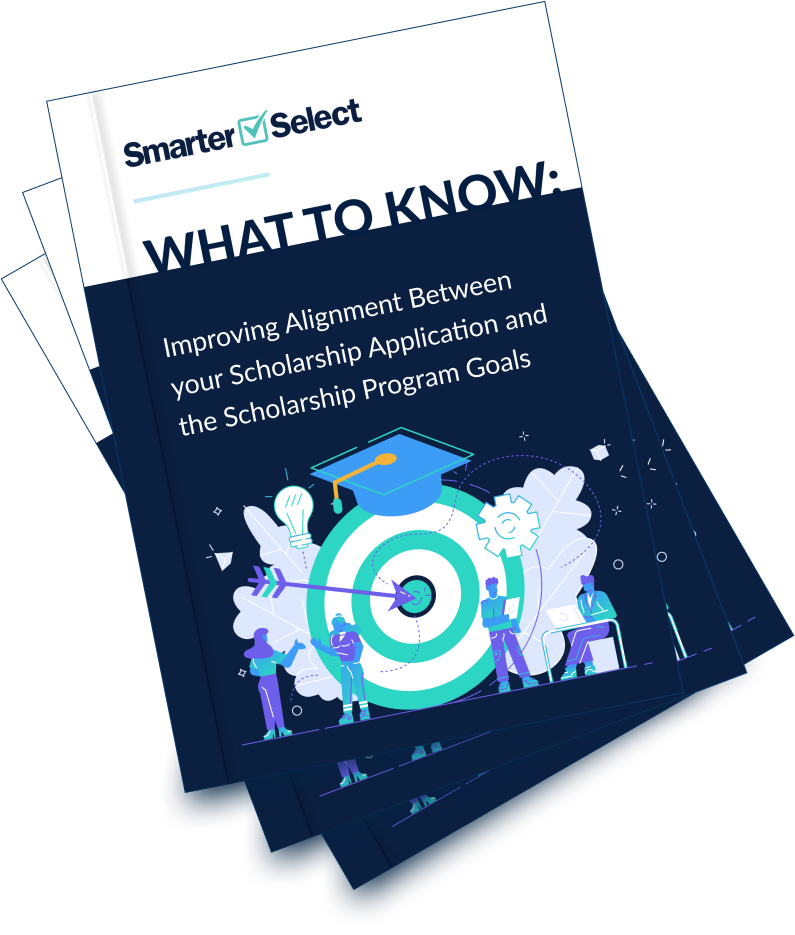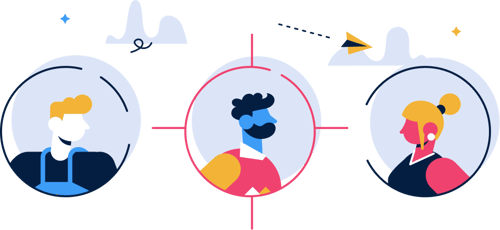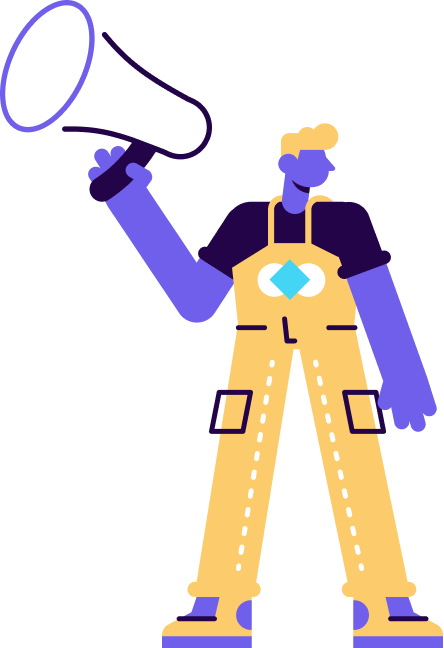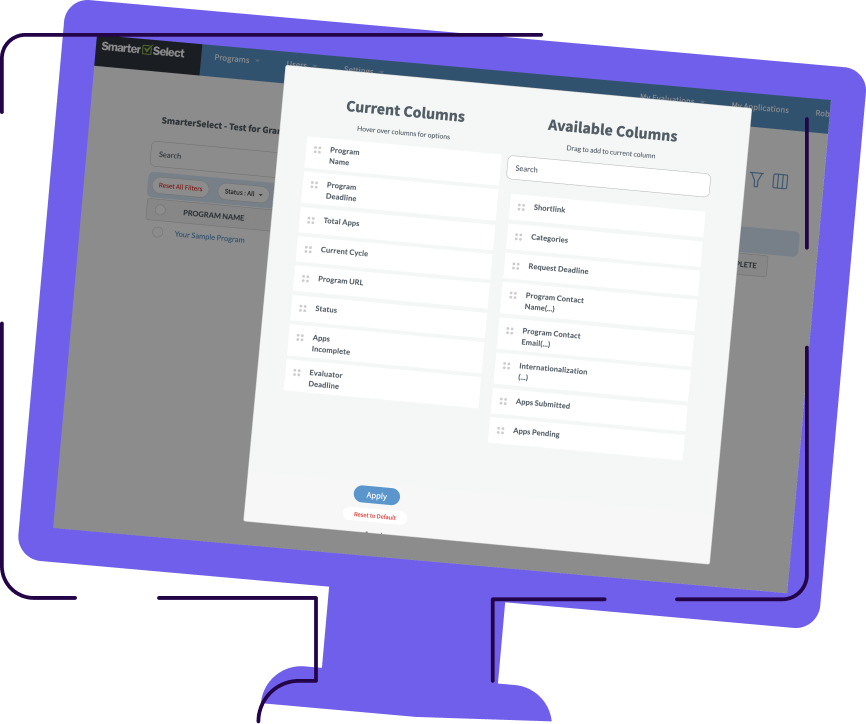What to Know:
Improve Alignment Between your Scholarship Application and Program Goals

Table of Contents
Running a scholarship program is supposed to be exciting and rewarding. Unfortunately, for the candidates filling out a scholarship application, and the evaluation team that has to choose the recipients, the entire experience can be quite frustrating.
The number one cause of this frustration? Not setting clear goals for your scholarship program and designing a scholarship application that is aligned with those goals. That’s why in this short eBook we’re going to walk you through the importance of establishing your goals, mistakes we see in programs, how to reach the right candidates, simplifying your evaluation processes and much more.

The reality is that when a scholarship program launches, applicants can struggle with how much information is required and what they should and shouldn't include. At the same time, scholarship committees and evaluation staff may struggle with the same issues.
The question is, “how can you find the highest quality applicants?” It all starts with defining who you want and then creating an application that reflects that. Before the task of creating your actual application however, it’s a good idea to spend time brainstorming and considering exactly what you’re looking for in a candidate. After you have defined the perfect candidate, then add qualifiers and application questions that speak to that unique persona.
CHAPTER 1
The Importance of Establishing Your Scholarship Program Goals

If you want your scholarship program to attract the best applicants, you must first do the work of establishing clear program goals. Setting clear goals can help inform the direction of your entire program, allowing you to ultimately reach the desired applicants.
Once you determine what the program goals are, it’s time to consider who your target applicants are, and write a scholarship application that accurately reflects them. Your program goals should be measurable and attainable as well. This will make the process of reporting on the success or failure of your scholarship program much easier.
For example, you’ll be able to answer questions like:
- Did our program find the people it was looking for?
- Did the recipients embody the mission and vision of the scholarship?
- Was the amount of money intended to be distributed awarded?
- Were deadlines met? And so on...
Starting With The Right Goals
The goals of your scholarship program will vary depending on the type of applicant you are looking for/want to attract. For example, if you want to attract high-achieving students and award them based on academic merit, using the words "academic merit" in your goals may be useful.
On the other hand, if you want to provide financial assistance to low-income students who need it most, it may be helpful to use terms such as "financial need" or "financial eligibility" in your messaging and scholarship application.

Consider These Questions About Your Ideal Candidate:
- Are they enrolled full-time or part-time?
- Are they studying in an undergraduate or graduate program?
- What is their GPA (grades)? (Is the program merit-based)
- What are the income requirements? (Is the program based on financial status)
- What are their expected family contributions (EFC)?
- Geographic location
There could be many factors at play when it comes to program alignment and crafting the right application form for your program. For instance, many scholarships are regional or national in scope, while others may restrict their competition to students who attend certain schools or hail from specific cities or states.

Go Deeper to Uncover More
- What does the applicant want out of their future?
- What field of study are they interested in?
- Do they want to continue their education immediately after school or work for a few years before pursuing higher degrees?
- Does employment status matter?
The goals of the program should also align with donors, partners, and stakeholders.
Pro tip: Setting scholarship program goals before seeking donors will help you to be more successful.
Answering some of the above questions, and considering your own goals and the goals of your donors, will serve as a guiding light in developing the criteria that candidates will use in applying for your scholarship program.
Create A Scholarship Program That Serves The Applicant
Once you know what you want the scholarship to achieve, and the candidate(s) you’re looking for, you can develop criteria that will help applicants determine whether or not they are in program alignment.
Having clear guidelines in place will help ensure an excellent pool of applicants with a high potential for success. Establishing your scholarship program goals early on will also simplify the task of writing your scholarship’s eligibility requirements

Think About Your Evaluators and Volunteers
Your scholarship application should be simple and easy for your evaluators to work with. Utilizing autoscoring and essay rubrics, in particular, can help streamline the evaluation process.When creating your application, consider who is evaluating it and how they will work with it. Make the process rewarding and simple by making everyone feel like an essential part of the process.
Be Proactive In Your Goal Achievement
Once you set goals for your scholarship program, it is time to work towards them. The scholarship program will only be successful if you hit your goals and objectives. Ensure that you have enough time to thoughtfully design your scholarship program
Setting the proper timeline allows you to create an application that reflects the goals you have created for your program.
Pro tip: Ensure resources are in place to achieve your goals and stay on track to accomplish them successfully.
Once you have established your goals, and considered your ideal candidate, it’s time to build your scholarship application. In the next chapter, we’ll explain how to write one in program alignment with your program’s goals.
CHAPTER 2
How to: Build Your Scholarship Application to Reflect the Program's Goals Effectively

At this stage, you should have a clear person in mind for your scholarship program. Now, we’ll dive into everything you need to know to build your scholarship application to reflect your program goals effectively.
What does it mean for a scholarship application to reflect the goals of your program? It means making it clear to applicants exactly who you are looking for. This helps to ensure that only the people who stand a chance of being chosen as a recipient will take the time to even apply in the first place.
Put another way, knowing your target audience will help you create an application that will attract just the right kind of students to your program. Here’s how to build out your application the right way:
1. Outline Eligibility Requirements
You want to make eligibility requirements clear and concise. By defining eligibility requirements, you are creating a specific definition of the type of candidates who will be chosen.
Consider the questions that will determine eligibility before proceeding to the next step.

2. Application Questions Need to be Relevant
Ensuring that your application questions are relevant is critical to building a scholarship application that draws in applicants you want. Questions should align with your scholarship program goals and be directly related to what you are looking for in eligible candidates.
For example, if you’re focusing completely on academic merits, you might not need to include questions related to socioeconomic status. These might be better in an application for a scholarship program focused on financial need.
Questions should help you reach your scholarship objectives, not be a burden on the applicant or your evaluation team.

3. Clear Instructions Are Important
Instructions that are easy to understand can be the difference between an application being filled out in its entirety and one that is abandoned midway through the process.
If the instructions are too complicated or too lengthy, you might lose out on some great candidates. Or you’ll find your team is answering a plethora of questions that could have been avoided.
When creating your scholarship application, think about what is essential for applicants to submit their best possible application.

4. FAQ Sections Can Save Time and Effort
If you want help explaining your requirements, adding an FAQ section to your application can be beneficial. An FAQ section is a great way to make sure that you communicate all of the necessary information for applicants and answer questions before they become an issue.
This will save time and effort for everyone both filling out and evaluating these forms.
In the next chapter, we’ll reveal the top application mistakes we see scholarship programs making. Our hope is that in seeing them, you can avoid them.

CHAPTER 3
5 Application Mistakes Scholarship Programs Make

When creating scholarship applications, the last thing you want to do is make mistakes that could cost you highly qualified applicants. That said, here are the five most common mistakes we see:
1. Asking Too Many Questions
The scholarship application should be built with program alignment in mind. Therefore, the questions asked should be directly related to what you are looking for in a candidate.

2. Failing to Communicate Requirements
There are bound to be some applicants who do not meet your eligibility requirements or have incomplete applications. It is therefore essential to communicate requirements early, often, and clearly, so applicants can begin the application process confidently and avoid misunderstandings.
3. Asking For Too Many References
References can help provide insight into an applicant's personality or character, but if you ask for too many, you may not get any responses at all. If your scholarship program goal is to find out more about the student, it might make sense to include three references in your application. If you are looking for an excellent student in the classroom, it might be better to ask for one or two references.
4.Not Using Autoscoring For Your Questions
Using autoscoring can help you avoid the time and effort of manual review. That’s why it’s a good idea to design questions that can be automatically tallied when possible. Automatic scoring means less time spent grading applications and more time spent recruiting the best candidates to your program.
5. Creating a Complicated Form
The more complicated your scholarship application, the harder it is for applicants to complete. A convoluted form can result in missing information and unclear directions, leading to fewer applications submitted overall. It’s better to create applications that are easy to understand and navigate.
Know why you are asking questions and what is necessary for applicants to submit their best possible application.

Build an Application People Want to Fill Out
When you are creating scholarship applications, be sure to keep it simple. A complicated application is likely to receive fewer submissions and more incomplete forms. While it’s true that those who do complete your form still might not be the best candidates for your scholarship program, improving clarity will get you that much closer to finding the cream of the crop. Keep it simple, and only ask for what you need.
In the next chapter, we’ll discuss how to find the candidates who are the perfect fit.
CHAPTER 4
Reach Candidates Who Best Fit Your Program

It’s important to remember that in the digital age, candidates have a lot of options available when it comes to selecting a scholarship program to pursue. Creating applications that communicate your mission and values, and that are easy to complete will help you gain the most interest.
Applicants want to know that a scholarship aligns with their goals and perspectives too. A marketing process targeting the right audience can help you attract and therefore select candidates who are most likely to succeed in your program.
Prescreening Potential Applicants
Prescreening is the first step in reaching the right candidates for your program (link to article 4). It can save both you and the potential applicants time and effort by narrowing down the pool of candidates. The three primary ways to prescreen applicants are through your scholarship description, the application, and the essay.
Your scholarship description is a great place to fill in basic information about who you are looking for and what your program hopes to achieve. If an applicant reads the description and finds it unsuitable for them they are much less likely to waste their time and yours by applying.

The scholarship application itself can also help you prescreen by asking specific questions about activities and experiences that align with your program goals. An applicant can quickly glance at it and know whether or not they can successfully answer your questions. If they can, they might move forward provided it’s not too long and technical.
The essay is the final element of prescreening and can help you confirm whether an applicant matches your program criteria and priorities. You want to ensure that finalists match up with what you desire, so be sure to put some time into writing quality essay questions.
Using scholarship management software like SmarterSelect, you can easily implement the prescreening methods mentioned here. You can build your form from scratch or use one of our templates to quickly add your eligibility requirements, questionnaire, essay questions, and more. We’ll share more on that shortly, however.
Utilize Social Media to Reach The Right Candidates
Social media is a great place to begin building your scholarship brand and find the best candidates for your program goals. Many potential applicants use social media, making it a valuable tool in recruiting prospective candidates.
You can link your scholarship application to your social media accounts for easy application access. Or you could post about past winners, share updates and use hashtags to drum up interest.

When using social media, remember to keep it simple and use language that helps attract your target audience.
Make Sharing Easy
Another critical thing to consider when creating a scholarship application is making it easy for applicants to share and promote the form. When your application is easily shared and accessible, applicants can help market your program and get you in front of other like-minded candidates.
Encourage applicants to invite their friends to share the application and help spread the word. Using what you have access to, like an email list, social media accounts, or a blog, will help you reach a wider applicant pool and increase the likelihood of finding a great fit.

Be specific in how you want applicants to share and what you want them to share, so they get your program in front of the right people.
In the next chapter, we’ll explore evaluation criteria and how you can use it to get that much closer to selecting recipients in program alignment with your mission and values.
CHAPTER 5
Your Evaluation Criteria Should Match Your Programs Goals

The evaluation criteria you set can be the difference between achieving your program goals and completely missing them. We discuss this more at length in this post, however, the key thing you need to know is that your evaluation criteria should align with your program goals and what you are looking for in a scholarship winner. The more specific, the better, especially when it comes to essay questions.
When deciding on evaluation standards, consider how it relates back to your program goals and what you want applicants to demonstrate through their responses.
Level of Involvement is Key
It is easy to give more weight to applicants who participate in the most programs, groups, or activities. Still, it is imperative to remember that your program is looking for a specific type of involvement.
You want applicants who show initiative and put time into what they are passionate about. Applicants who participate in a few groups, but show leadership in these groups should not be overlooked.
For example, showing leadership in a community service club by organizing events or leading committees should outweigh someone simply being a member of multiple clubs.
Pro Tip: Level of involvement matters, and you shouldn’t select scholarship applicants solely based on how many activities they are involved with.
Essays Hold The Most Weight
The essay portion of an application holds the most weight because it is your opportunity to learn the most about applicants and what they care about. Essays also give evaluators a chance to see more in-depth answers from applicants rather than the perfectly crafted narrative yes and no or multiple choice questions can create.
Define Your Evaluation Score
Having a rubric or guideline will help you avoid grading mistakes and ensure consistent scoring among evaluators. When creating your evaluation criteria, it should be easy for evaluators to understand what they are looking for when reading an application.
A scoring guide should include the order of importance, how many points will be awarded per component, and any comments or notes that may impact the score.
Pro Tip: Use a straightforward scoring system for essays. Give applicants a score of 0 to 15, with 0 being an essay that wasn't well written and 15 is well thought out, well written, and insightful.
"Hide From Evaluator"
The hide from evaluator feature is one of the many reasons program managers love SmarterSelect scholarship application software. This feature allows you to limit the candidates' data so evaluators can focus on evaluation questions and essays instead of who it is that is applying. Using the "hide from evaluators" feature also makes evaluators unable to see other calculated scores, allowing for minimal distractions and faster essay scoring.

Use Calculation Tools
Another awesome feature of SmarterSelect scholarship management software is our calculation tool that adds up all scores and rubrics. Scoring by hand may lead to errors when adding all scores together from rubrics.
Giving a score for each section and then adding them up will provide a single score that can be used to determine a candidate's level of program alignment. The main goal of scoring is to yield the highest score possible to reveal the person or people that are a perfect match for your program.
Input From Team Members/ Evaluators Matters
It is a good idea to create an environment where input from evaluators and team members matters. The best scholarship programs allow others to provide feedback on applications as it helps gather more information about an applicant and could lead to identifying better applicants.
The longer you run your program, the easier this becomes.
Pro Tip: As the program manager, you should not be the only person providing feedback on scholarship applications or deciding who is awarded a scholarship. Evaluators and team members can see opportunities or discrepancies that you are missing.
CHAPTER 6
How to Create a Program Report For Donors

Creating a scholarship program report can be an effective way to provide donors with updates on the status of their scholarship program.
Program managers often use SmarterSelect scholarship application software to generate reports for donors as an easy way to show donors how effective the program is. It is important to keep donors updated to know that their money and donations go toward a well-managed program.
When creating reports for donors, you must be honest and transparent about how the program is running. Sometimes managers make scholarship reports that are unintentionally misleading or don't show all of the information, leading to problems later on. This often damages the relationship with the donor because they feel like their money isn't being used properly.
Remember these 3 key things when creating donor reports:
- Be ethical
- Be concise
- Keep the language simple
SmartSelect makes creating donor reports easy:
- First, create a view in our scholarship management software
- Select the columns needed
- Apply Filters
- Click to Export
- Easily send the info as PDF or .csv/.xlsx format
This is the easiest way to create a donor report that will effectively communicate the status of your scholarship program. Ensure the data you select is relevant and the language and wording you use are to the point.

Reward and Recognize
Rewards and recognition can often make a scholarship program more successful. You can utilize events to showcase recipients and give them an opportunity to network with donors and other team members.
Scholarship award ceremonies are also a great way to have a well-organized and structured event that will allow you to publicly recognize your top applicants.
Pro Tip: In addition to the scholarship award ceremony, it is helpful to do things such as create a scholarship newsletter, post about recipients on social media, or show video testimonials.
Donor Relationships Should Be Nurtured
When it comes to scholarship programs, long-term success is based mainly on relationships with donors.
There are many ways that you can take advantage of building relationships with your donors:
- Develop email drip campaigns
- Send thank you gifts, like chocolates or wine (don't forget to ask what kind of gift they prefer)
- Keep in touch with them about what their donations are being used towards
Donors want to hear about the progress you are making with their capital.
Make sure that you keep your donors in the loop and engage those who have donated, as they want to know how their donation is being used and affecting applicants' lives.
Nurturing these relationships will help you create a more successful scholarship program and long-term viability for your organization. Allow your donors to feel pride by being a part of the future success of your program.
In the final chapter we’ll share the best tool for creating and running a scholarship program that is aligned with your goals, mission, and vision.

CHAPTER 7
SmarterSelect - The Scholarship Management Software Program Managers Rely On

We’ve alluded to it a few times throughout this eBook, but SmarterSelect is hands down the best software on the market for scholarship program management. Since 2007 we’ve helped hundreds of program managers just like you create scholarship application forms that are perfectly aligned with their goals.
From our scholarship application templates to our community forum, easy to understand training to our exceptional customer service, SmarterSelect gives you all the tools you need, and many you likely don’t even realize you want. Anyone can create a scholarship program, but not everyone can run an effective program as effortlessly as the managers who use our software.
While many companies can claim they are a great value for the money, we have the social proof to back it up. Here are just a few examples of what others have said:
- “Easy to use”
- “Excellent for the price!”
- “Helps you work more effectively and efficiently”
- “It is a good product and meets our needs.”
- “The customer service is amazing. I know that I will receive the help I need.”
- “I have had great success with the capabilities of the platform and have received positive feedback.”
Read our reviews page to see even more of what others are saying about us. Then again, we’ve always felt show is better than tell!
See for yourself how we can help you align your scholarship program goals with your application to yield the best possible candidates for your next scholarship period. Start a free trial today.
Start Aligning Your Scholarship Application and Program Goals Today!
Priced for non-profits. No set-up fees.
No long-term contracts. Powerful features.
Go live in less than 24 hours.
